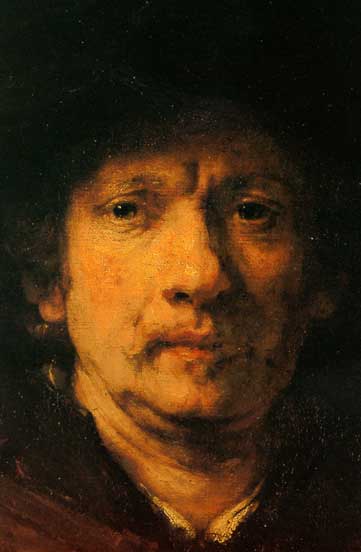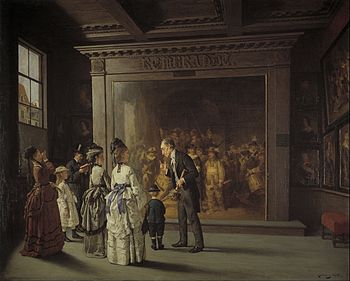REBRAND AND THE NIGHT WATCH, ONE OF MY FAVOURITES
KEY ELEMENTS
The painting is renowned for three characteristics: its colossal size (363 cm × 437 cm (11.91 ft × 14.34 ft)), the effective use of light and shadow (tenebrism) and the perception of motion in what would have traditionally been a static military portrait.
The painting was completed in 1642, at the peak of the Dutch Golden Age. It depicts the eponymous company moving out, led by Captain Frans Banning Cocq (dressed in black, with a red sash) and his lieutenant, Willem van Ruytenburch (dressed in yellow, with a white sash). With effective use of sunlight and shade, Rembrandt leads the eye to the three most important characters among the crowd: the two gentlemen in the centre (from whom the painting gets its original title), and the woman in the centre-left background carrying a chicken. Behind them, the company's colours are carried by the ensign, Jan Visscher Cornelissen.
Rembrandt has displayed the traditional emblem of the arquebusiers in a natural way, with the woman in the background carrying the main symbols. She is a kind of mascot herself; the claws of a dead chicken on her belt represent the clauweniers (arquebusiers), the pistol behind the chicken represents clover and she is holding the militia's goblet. The man in front of her is wearing a helmet with an oak leaf, a traditional motif of the arquebusiers. The dead chicken is also meant to represent a defeated adversary. The colour yellow is often associated with victory.
Another interpretation proposes that Rembrandt designed this painting with several layers of meaning, as was common among the most talented artists. Thus, the Night Watch is symmetrically divided, firstly to illustrate the union between the Dutch Protestants and the Dutch Catholics, and secondly to evoke the war effort against the Spaniards. For instance, according to Rembrandt's multilayered design, the taller captain (in black) symbolizes the Dutch Protestant leadership, loyally supported by the Dutch Catholics (represented by the shorter lieutenant, in yellow). Moreover, all characters of this painting were conceived to present double readings.
One of the most important aspects of the Night Watch is that the figures are nearly human size. Rembrandt gives the illusion that the characters jump off the canvas and into real space.
ALTERATIONS TO ORIGINAL
For much of its existence, the painting was coated with a dark varnish, which gave the incorrect impression that it depicted a night scene, leading to the name by which it is now commonly known. This varnish was removed only in the 1940s.
In 1715, upon its removal from the Kloveniersdoelen to the Amsterdam Town Hall, the painting was trimmed on all four sides. This was done, presumably, to fit the painting between two columns and was a common practice before the 19th century. This alteration resulted in the loss of two characters on the left side of the painting, the top of the arch, the balustrade, and the edge of the step. This balustrade and step were key visual tools used by Rembrandt to give the painting a forward motion. A 17th-century copy of the painting by Gerrit Lundens at the National Gallery, London shows the original composition.
PAINTING'S COMMISSION
The painting was commissioned (around 1639) by Captain Banning Cocq and seventeen members of his Kloveniers (civic militia guards). Eighteen names appear on a shield, painted circa 1715, in the centre right background, as the hired drummer was added to the painting for free. A total of 34 characters appear in the painting. Rembrandt was paid 1,600 guilders for the painting (each person paid one hundred), a large sum at the time. This was one of a series of seven similar paintings of the militiamen (Dutch: 'Schuttersstuk') commissioned during that time from various artists.
The painting was commissioned to hang in the banquet hall of the newly built Kloveniersdoelen (Musketeers' Meeting Hall) in Amsterdam. Some have suggested that the occasion for Rembrandt's commission and the series of other commissions given to other artists was the visit of the French queen, Marie de Medici, in 1638. Even though she was escaping from her exile from France ordered by her son Louis XIII, the queen's arrival was met with great pageantry.
LOCATION
The Night Watch first hung in the Groote Zaal (Great Hall) or Amsterdam's Kloveniersdoelen. This structure currently houses the Doelen Hotel. In 1715, the painting was moved to the Amsterdam Town Hall, for which it was altered. When Napoleon occupied the Netherlands, the Town Hall became the Palace on the Dam and the magistrates moved the painting to the Trippenhuis of the family Trip. Napoleon ordered it returned, but after the occupation ended in 1813, the painting again moved to the Trippenhuis, which now housed the Dutch Academy of Sciences. It remained there until it moved to the new Rijksmuseum when its building was finished in 1885.The painting was removed from the museum in September 1939, at the onset of World War II. The canvas was detached from its frame and rolled around a cylinder. The rolled painting was stored in Radboud Castle in Medemblik, north of Amsterdam. After the end of the war, the canvas was re-mounted, restored, and returned to its rightful place in the Rijksmuseum.
On 11 December 2003 The Night Watch started its move to a temporary location, due to a major refurbishment of the Rijksmuseum. The painting was detached from its frame, wrapped in stain-free paper, put into a wooden frame which was put into two sleeves, driven on a cart to its new destination, hoisted, and brought into its new home through a special slit.
While the refurbishment took place, The Night Watch could be viewed in its temporary location in the Philipsvleugel of the Rijksmuseum. When the refurbishment was finished in April 2013, the painting was returned to its original place in the Nachtwachtzaal (Room of the Night Watch)
Was lucky to see it in the Rijksmuseum live :) And it was a truly great experience, didn't imagine it was so huge :) Thx for the article!
I like that there are people in the steem that appreciate the arts.
Hi! I am a robot. I just upvoted you! I found similar content that readers might be interested in:
https://www.flickr.com/photos/terryjeantrevellion/27048038155